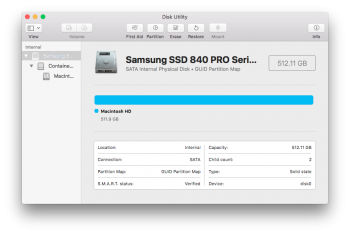I created a new usb Mojave patcher with the added APFS patch and just like you it was gray out, so formatted my internal hdd to APFS then rebooted into the patcher and the APFS patch was not greyed out installed the latest beta applied the post install patches hit option on reboot and was presented with a EFI and recovery option the only HDD that appeared normal was my external hdd macOSUSB,EFI,recovery. Then name of my formatted internal hdd MacintoshHD is not appearing
Thanks for the reply.
I know I asked this question before (but never got a response back).
Is there an advantage of APFS ROM boot? My MBP5,3 currently has 3 partitions and it's working well.
- Internal SSD partition - High Sierra (patched using @dosdude1's HS Patch app.
- Internal SSD partition - Sierra - installed regularly as it is supported.
- External HDD partition - Mojave Beta (patched using @dosdude1's Mojave Patch app.
Thank You.


